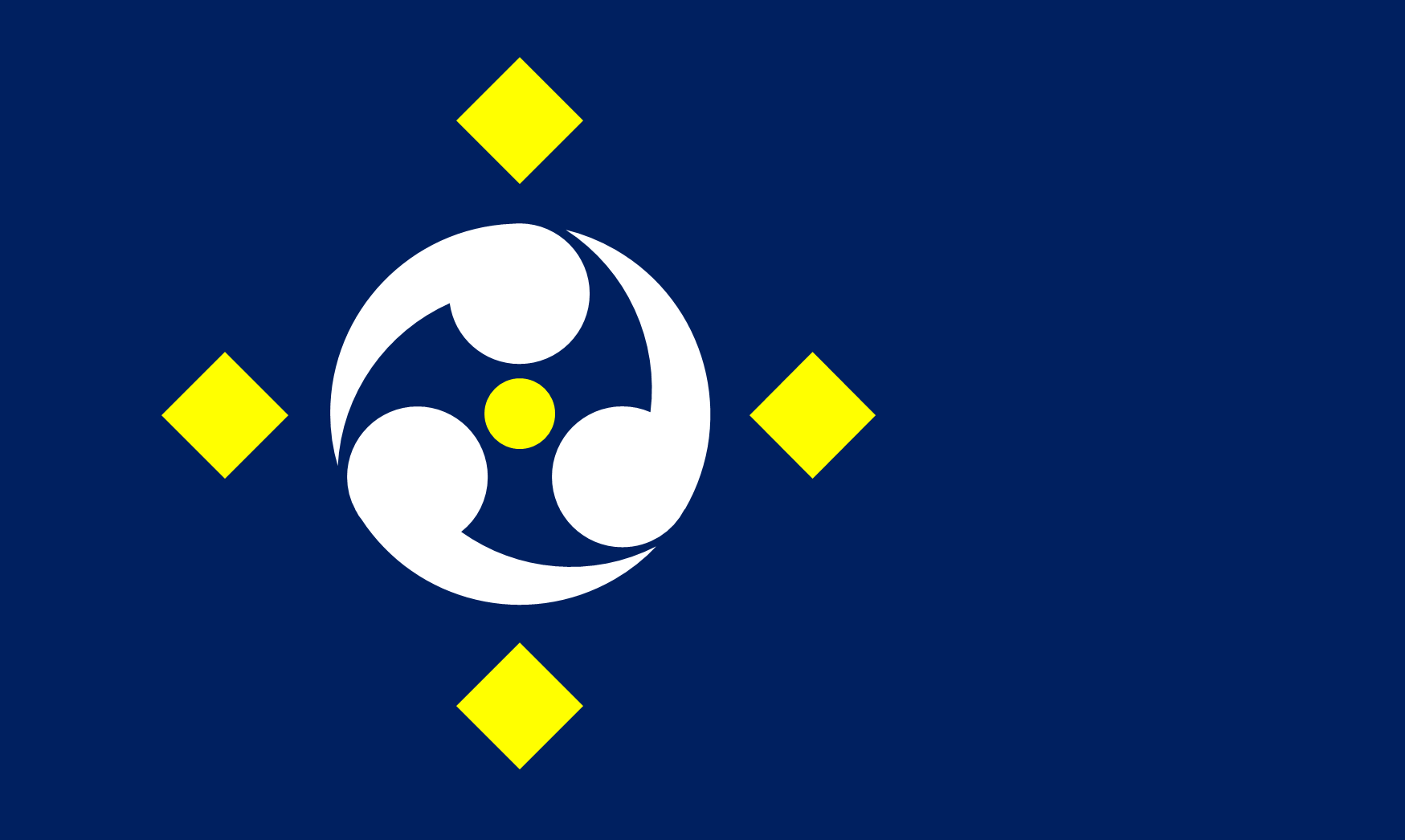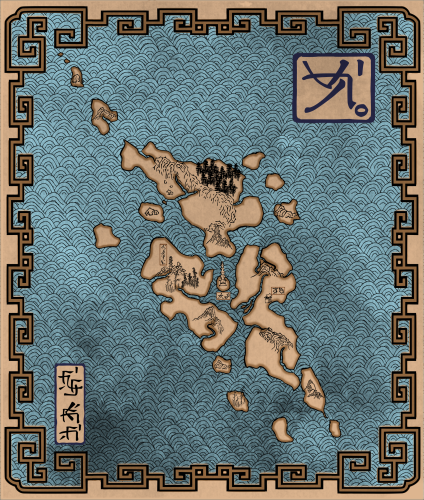Mitzu
To be found to the south west of Ara, west of Ebrion and to the south of Vozdukh, lies Mitzu.
Once a large continent, a calamity caused most of the continent to sink, leaving a collection of many islands. The major island is Karta, the second largest is Odon.
It is ruled by the Imperial Line of Mitzu.
Structure
The Empire of Mitzu is official ruled by the Emperor. The Emperor is supported by a Vizier-like individual, the Arakon who acts as an advisor and, especially during the Seclusion, act for the Emperor within the world.
However, in reality, that leadership is secured by the relationship fostered with the leaders, or Isika, of each of the Iparaku of Mitzu. These form the Council of the Isikaya.
In the case of the death of the Emperor with no apparent heirs, historically a new Emperor has been found from the Isikaya. They traditionally then renounce their tribe and an new Isika elected.
Outside of the Isikaya and their Iparaku, there is significant political influence from the Monastic orders, and also two shadowy Cabals - the School of the Spider and the School of the Scorpion
| Isika | Iparak | Territory |
|---|---|---|
| Vaka Sani (deceased) | Kikani | Kita |
| Koyama Hisa | Azumani | Azuma |
| Shizu Kune | Katani | Karta |
| Yakan Gawa | Nishini | Nishi |
| Suki Rumi | Mulini | Mul |
| Hiki Yunin | Odoni | Odon |
| Matsu Tomio | Olippini | Olippi |
Culture
The Mitzui are divided into an number of tribes with varying cultures (and cultural stereotypes). However, there are some uniting elements.
In general, the Mitzui value excellence in one's field, be it intellectual & academic, physical or fiscal. There is also a culture of honour and loyalty to one's family, tribe and country. Most are relatively open to outsiders, most so in the south, and less so to the North. Being composed of so many islands, the Mitzui are keen seafarers and it is a very maritime kingdom – lots of explorers, water very important.
Language
As well as racial languages, the people of Miztu speak a dialect of Common, called Mitzui. It is written in their alphabet of TakodeFood
The Mitzui dislike cooking upon open flames. As such, most food is boiled, steamed, steam-ovened or fried on large hot meal plates. Grain is largely wet-wheat based, eaten either as steamed bread or boiled into sticky grains, sometimes formed into dumplings or rolled in seaweed with additional vegetable or protein additions. Protein largely is derived from fish & sea-birds (which also provide eggs) in the diet, though some pork is also reared on the larger islands. Sauces are popular with foods, often using imported spices appropriate to the consumer's wealth. Fermentation is also used for pickles and sauces, and some teas. However, alcohol is less prevalent here than in other areas of Ara with the major beverage being a wide range of teas.Architecture
Common Mitzui buildings are built with white-washed wood. In cities, particularly the capital, stone is more prevalent, particular in richer buildings. The white stone of Mitzu is the most prestigious and is used to dazzling extent in Szhen-Dgou. This is usually coupled with hip-and-gable style roofing, with corners rounding up to be higher than the sides. Blue is the most prestigious colour for roofing. This may be achieved through painted wooden shingles, slate and varying quality Mitzu blue Lapis.Fashion
Clothing is mostly in the form of robes of silk. Layering is important, with clothing specially designed for professions and to sit on top of armour. Blue and white are common, as auspicious colours, but there is a wide variety available based on budget. Some colours and styles are restricted to certain professions and classes. Furs are more common in Northern regions, while in some Southern regions it is common to bare one's chest.Iparaku
Mitzui citizens owe loyalty to a tribe or Iparak. These are regional groupings as well as connected by family. It is possible to change Iparak, though many who move within the country retain their former allegiance and this is normally accepted. Historically, the territories of these tribes were disputed and fought over, though for the last century or so, they have been relatively stable. These tribes all have their own rich and varied cultures and histories, though also have lazy stereotypes associated with them by the other Iparaku.| Tribe | Region | Stereotypical Traits/outlook |
|---|---|---|
| Kikani | Kita | Isolationist. Untrustworthy of outside influences and relatively hostile to immigration, particularly from outside Mitzu |
| Azumani | Azuma | Diplomats, but also in the extreme viewed as cunning, sly and manipulative. Representatives from the Azumani are largely responsible for the domestic stability Mitzu now enjoys |
| Katani | Karta | Place strong value in might and power. Seen as militaristic and pugilistic |
| Nishini | Nishi | Highly traditionalist and resistant to change. Often ally in disagreements with the Kikani |
| Mulini | Mul | Famed for their wisdom, criticised for their idealism over pragmatism. Home to many monastic and academic traditions, a Mulini accent can advantage one - sometimes unfairly. |
| Odoni | Odon | Viewed as the business powerhouse of Mitzu, the Odoni are viewed as mercantile and sometimes avaricious |
| Olippini | Olippi | Being at one of the extremes of the territory, Olippi has been the starting point of many explorers. People from this region are believed to be adventurous, though often dismissed as dreamers. |
History
Mitzu was founded by Emperor Tshanhona gathering the survivors from the calamity. Nearly all pre-calamity organisations, assets and infrastructure were lost, with the exception of some in very mountainous regions. As such, any remaining items are highly prized and valuable
Demography and Population
Mitzu is home to most of the races of Ara, with prevalence in descending order:
- Humans
- Elves
- Dragonborn
- Half-elves
- Halfings
- Orcs & Half-orcs There are very few dwarven peoples native to Mitzu. It is said that they dislike the native Lapis blue and white rocks.
Territories
The Empire of Mitzu covers a number of major islands. These are:
- Szhen-Dgou - The small island that is the capital
- Kita (The Northern Islands) - Coolest of the islands with famously harsh winters
- Azuma (The Eastern Islands)
- Karta
- Nishi (The Western Islands)
- Odon - the largest landmass of the island group
- Mul - the second largest island
- Olippi (The South Islands)
Religion
Mitzu is home to many significant monastic orders. Three major orders are listed below:
Agriculture & Industry
appearance

Founding Date
0 PR
Type
Geopolitical, Empire
Capital
Alternative Names
The Empire of Mitzu
Demonym
Mitzui
Leader
Ruling Organization
Leader Title
Head of State
Government System
Monarchy, Absolute
Power Structure
Feudal state
Economic System
Traditional
Official State Religion
Location
Related Ranks & Titles
Controlled Territories
Neighboring Nations
Related Items
Related Ethnicities
Related Myths
Important Locations
Szhen-DgouTakoyenka
Sacrarium of Water
Key Characters from Mitzu
GambleShinsuke
Karu
Emperor Hinonanba
Empress Hinonila
Arakon
Vaki Sani
Matsu Tomeo

















Comments